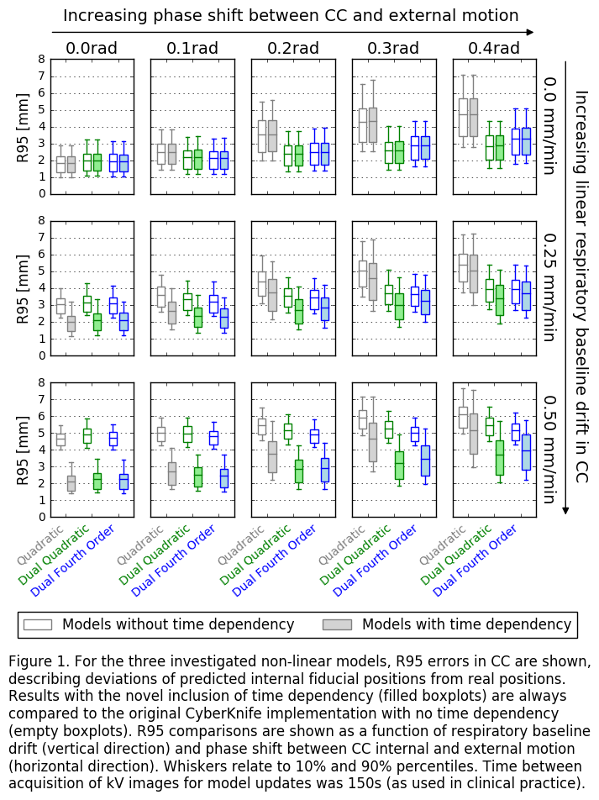Time-dependent non-linear respiratory tracking models to cope with complex breathing motion patterns
Marta Giżyńska,
The Netherlands
PD-0228
Abstract
Time-dependent non-linear respiratory tracking models to cope with complex breathing motion patterns
Authors: Marta Giżyńska1, Yvette Seppenwoolde1, Ben Heijmen1
1Erasmus MC Cancer Institute, University Medical Center Rotterdam, Department of Radiotherapy, Rotterdam, The Netherlands
Show Affiliations
Hide Affiliations
Purpose or Objective
Correlations between
external marker positions and internal fiducial positions are used by the
robotic CyberKnife (CK) for tracking of tumors with respiratory motion. Applied
correlation models are established pre-treatment and updated during treatment.
Apart from linear models, the CK can also use non-linear models, e.g. for
handling phase shifts between internal and external motion. Currently, none of
the implemented models has an option to explicitly include time dependency to
account for baseline drifts. In this study, we extended the currently
implemented non-linear models with an explicit time dependency, and we compared
accuracy of predicted internal fiducial positions with and without this option for
respiratory motion tracks including baseline drifts and phase shifts between
external and internal motion.
Material and Methods
Existing quadratic,
dual quadratic and constraint dual fourth order CK models were extended with an
option for fitting explicit linear time dependency during model updates. For 7500
synthetic patients, simulations were performed to establish inaccuracies in
predicted internal fiducial positions with and without the novel time dependency
extension. In building and updating of the novel models, the time dependency was
only applied in case of detected statistically significant baseline drifts. A
respiratory track generator was used to create motion tracks for the synthetic
patients. For each track, respiratory motion baseline, amplitude, period, shape
and noise were randomly drawn from distributions found in literature. Additionally,
phase shifts of 0, 0.1, 0.2, 0.3 and 0.4rad, and linear baseline drifts of 0,
0.25 and 0.5mm/min were added to respiratory motion tracks in CC direction. For
each treatment simulation, the prediction error in CC was quantified by R95; for
95% of the radiation time, the distance between the predicted and real internal
fiducial position is ≤ R95.
Results
For the three
investigated non-linear models Fig. 1 shows R95 differences between tracking
with and without time dependency for a range of phase shifts and baseline
drifts. In contrast to the current non-linear CK models, inclusion of time
dependency could to a large extent avoid increase of predicted errors caused by
baseline drifts. E.g. for a 0 phase shift, mean R95 for the dual quadratic
model with time dependency went up from 2.0mm for 0mm/min drift to only 2.3mm
for 0.5mm/min drift, while for the conventional dual quadratic model the increase was
much larger, from 2.0mm to 4.9mm (Fig. 1). For larger phase shifts,
time-dependent models still did better than the original models, but
differences were slightly smaller (Fig. 1).

Conclusion
The proposed non-linear
correlation models with explicit time dependency significantly enhanced the
accuracy of internal fiducial position prediction in respiratory tracking, compared
to currently implemented CyberKnife models, while keeping the number of
acquired X-ray images fixed.